Features of caring for Thunberg barberry, rules for planting shrubs
Connoisseurs of ornamental shrubs should pay attention to the Thunberg barberry, planting and caring for which will not be difficult even in the absence of experience in gardening. Its popularity is easy to explain. This plant has many advantages. Among them are spectacular appearance, undemandingness to soil fertility, resistance to disease and pests, the ability to grow rapidly.
Under the general concept of Thunberg barberry, there are many varieties that differ from each other in appearance, but are similar in agricultural technology. The shapes and sizes of their crowns and options for the color of the leaves are so diverse that every gardener can choose the plant that conquered him. Atropurpurea Nana, Darts Red Lady, Admiration, Kornik, Orange Dream, Golden Ring, Maria - all these are Thunberg barberry varieties, and their names can be listed for a long time.
Suitable plot
For planting shrubs, it is better to choose an open, well-lit place on the site. It tolerates light shading well. In a dense shade, the plant will not die, but the lack of light will negatively affect its decorative effect. First of all, this concerns the Maria variety, as well as the red-leaved varieties of the Thunberg barberry. The color of their leaves from bright and rich will turn into faded and expressionless.
You can plant a shrub on any soil. In nature, it is often found on nutrient-poor, but loose sandy lands - on the banks of rivers, on the slopes of ravines.
In order for the Thunberg barberry to develop successfully, the soil must meet only two requirements:
- be well drained;
- freely pass air to the root system of the plant.
The culture tolerates drought easily, but is highly sensitive to moisture stagnation. If the site is characterized by a high occurrence of groundwater, a thick drainage layer of expanded clay or crushed stone is laid on the bottom of the planting pit. Heavy, poorly permeable and moisture-retaining soil with a high clay content is best facilitated by the introduction of leaf humus, compost and sand. The first component can be replaced with forest soil.
For the Admiration variety, a light and nutritious substrate of three components mixed in equal amounts is ideal:
- garden land;
- humus;
- sand.
It is better to place Mary's cuttings in organic-rich and moist soil. Prefers neutral soil shrubs. If the soil on the site is acidic (with a pH value in the range of 6-7.5), limestone, slaked lime or wood ash are added to it.
Landing features
In open ground, the Thunberg barberry is usually planted in the spring. In order for the shrub to take root well in a new place, it is important not to be late with the timing of the procedure. It is carried out while the buds of the plant are still sleeping. An autumn planting of bushes that have already passed into a state of dormancy is also possible. Some gardeners consider it more effective, since the growing season for a plant does not begin immediately, but only the next year. Others prefer not to risk it, since there is a high probability of freezing out young barberries.
The planting scheme depends on the desired result and the selected variety. Dwarf plant forms, for example, Admiration, can be placed closer to each other - at a distance of 0.5 m.At least 1.5-2 m of free space is left between tall single bushes. They will need it for full development. They are planted in pre-dug pits, the depth of which should be 35 cm and the width - 50 cm.If it is planned that in the future the barberry will form a hedge, the distance between the plants is reduced to 50 cm. It is more convenient to plant them in a trench.
A layer of sand is poured at the bottom of the recess, it will allow the root system of the bush to breathe better. Then it is filled with a nutritious soil mixture into which the plant is placed. Gently spreading its roots, the pit is covered with a prepared substrate. Near the bush, it is compacted, after which the seedling is abundantly watered. The soil near the trunk of the plant must be mulched. It is better to use organic material for this (humus, dry leaves). In spring, the barberry will take over faster if the top of the seedling is cut to the level of 3-5 buds.
Advice
Special preparations - growth accelerators - will have a good effect on the rooting of a young plant. They are sprayed with a seedling before being placed in the ground.
Until the shrub takes root in a new place, it needs regular watering. They are carried out in the spring every 10 days, preventing the soil from drying out. The lack of moisture can be judged by the appearance of the soil at the base of the plant trunk. If a dry spider web appears there, this is a sure sign that the seedling needs to be watered urgently.
Watering and feeding rules
Barberry Thunberg is extremely unpretentious, it won't take a lot of time to care for it in spring and summer. The shrub is rarely watered. In dry weather, it is enough to do this only once a week, and on rainy days, it will have enough natural moisture. You need to pour water only at the root, trying not to overdo it with the amount of liquid. Most plant varieties tolerate its lack, but an excess can affect them badly.
For some varieties of culture, an exception will have to be made. If the barberry Thunberg Maria is grown in the sun, the shrub should be watered regularly. Otherwise, its rich yellow leaves with a spectacular red border can burn and even crumble. A layer of mulch will help keep the moisture in the soil necessary for the plant. It will need to be added as needed. Both Admiration and all other varieties of this barberry respond well to loosening the soil. It performs 2 functions at once:
- facilitates the passage of oxygen to the roots of the bush;
- allows you to easily and quickly get rid of weeds that interfere with its full development.
Barberry Thunberg is a fruiting plant, but it will delight with the harvest only with proper care, which involves regular feeding. They begin to carry out them when the age of the shrub reaches 2 years. In the spring, compositions with a high nitrogen content are important for him. A good result is given by watering barberry urea solution (20-30 g of the drug per 1 bucket of water).
From summer to autumn, complex mineral preparations rich in phosphorus and potassium are used for fertilization. Repeat feeding according to this scheme every 3-4 years. Experienced gardeners sprinkle compost on the soil near the plant's trunk. It is recommended to do this twice during the growing season.
Pruning and preparing for winter
Tall varieties of Thunberg barberry need annual pruning. It is most convenient to carry out it in early spring, while the leaves on the plant have not yet blossomed, but you can postpone the procedure until late autumn. Pruning allows you to make the shrub healthier and increase its decorative effect. In order for a plant to be strong and beautiful, it is necessary to ruthlessly remove from it the branches affected by diseases and pests, dry, weak, underdeveloped and directed into the bush. As a result, strong and viable shoots are better lit and have more room for development.
A procedure is also needed to give the bushes a culture of the desired shape. If their crown is friable, it is impossible to do without shortening the branches sticking out of it. As part of a hedge, barberry is trimmed only after reaching 2 years of age. You can safely remove up to ⅔ shoots. The procedure is carried out twice a season: in the first and last days of summer.
Most dwarf and red-leaved varieties (Admiration, as well as barberry, in the name of which there is the prefix "red"), frequent pruning is not required. Their crown itself is compact and does not need shaping. They are pruned exclusively for sanitary purposes, removing frost-beaten and excess branches. Many gardeners do not trim low-growing plant varieties at all.
One of the advantages of Thunberg barberry is its high frost resistance. It can easily withstand temperatures as low as -35 ° C. Even if its bushes freeze a little, with the beginning of the growing season, they will gradually restore their lush crown. Almost all varieties of this barberry, and in particular Admiration, are suitable for growing in regions with harsh winters. But in the first years of life, while the shrub has not yet matured, it is better to cover it during cold weather with withered foliage, dry needles or spruce branches. For evergreen crop varieties, such protection is required within 2-3 years after planting in the ground.
It is a pleasure to grow Thunberg barberry on the site, because you don't have to pay much attention to plantings, and you can admire their catchy beauty for a long time. In spring, the shrub attracts attention with its unusual flowers, in summer - with bright foliage of various, sometimes even contrasting shades. In the fall, scarlet berries will complement his outfit.
The shrub needs almost no care, it is not affected by dangerous diseases - rust and powdery mildew. His agricultural techniques will seem familiar to those who have experience in breeding other types of barberry. This plant is not afraid of either a dry hot summer or severe frosty winters. Even his single bushes will become the highlight of the site. And in group plantings, they turn into a charming hedge that can replace the standard boring fence: uninvited guests will not be able to get through the dense thickets covered with sharp thorns.
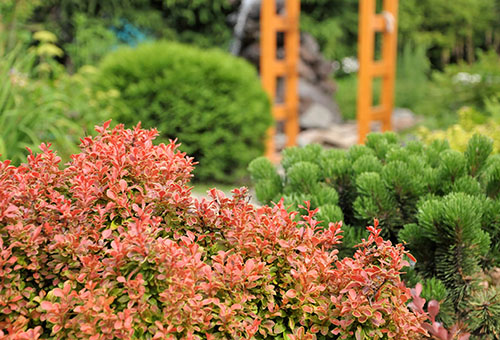
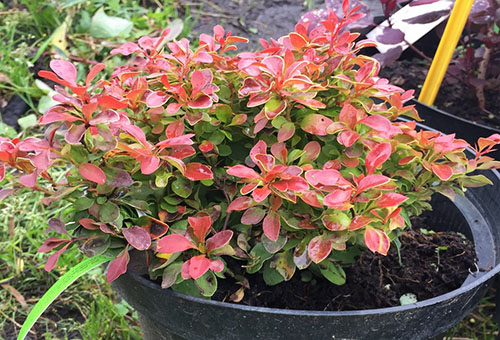
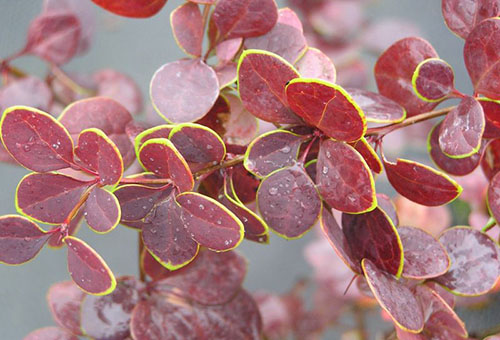
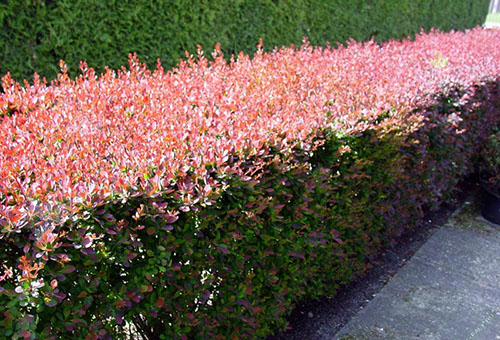
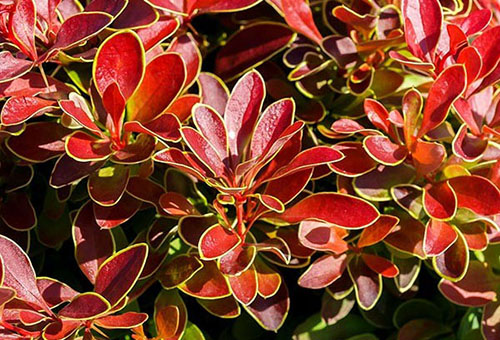
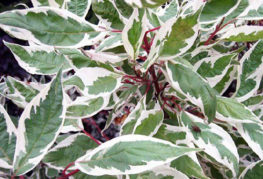
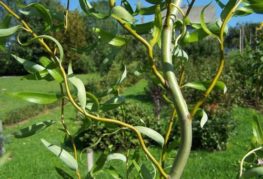
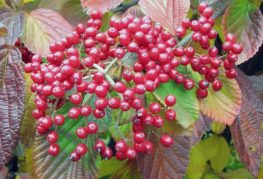
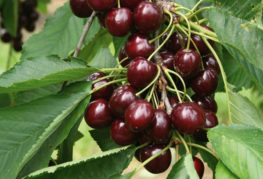
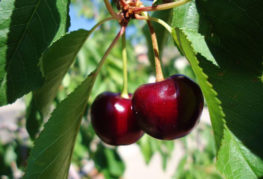
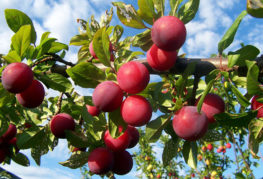
and will be published shortly.